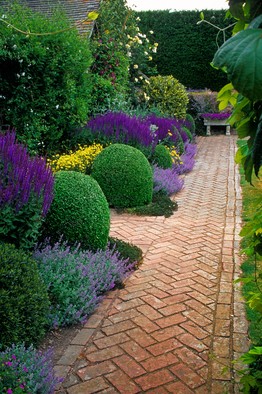 There are so many choices when it comes to surfaces for a patio or walkway or other hardscape area. Homeowners have choices of brick, flagstone, bluestone, limestone, slate, marble, granite, concrete, gravel and mixed materials. Here are our takes on some of the more commonly chosen materials by our customers. Poured Concrete - Concrete is generally a less expensive alternative to individual pavers, stones or bricks. Concrete can offer different looks, as it can be stained, stamped, brushed or scored. Stamped concrete is gaining in popularity because it can often look very much like real cobblestone, brick or other pavers and in any number of patterns. However, even with extra preparation for colder Massachusetts weather, concrete will not have the durability or longevity of individually placed stones or pavers. It will likely crack over time. Concrete Pavers - Concrete pavers are less expensive than real stone pavers and have minimal maintenance and a number of options. Some look like plain concrete squares and others have textures, shapes and colors to make them look like real stone. This tends to be a better material for Do-It-Yourself homeowners, as concrete pavers are typically available at big box home improvement stores and often have interlocking components on them. Natural Stone Pavers - Almost any type of stone can be cut and used as pavers. Most of the stones we use tend to be made of sandstone, slate, flagstone and granite. They are typically cut in sizes of 6 x 12," 12 x 12," or 18 x 18." The colors can vary and they can be installed in a number of patterns. Natural stone pavers are a durable, long lasting material. An experienced, professional landscaper or mason works quickly and installs a patio with a supportive base and even spacing that looks great. Brick - Brick is a classic material that is found in century old homes, so it has a charm that some other materials don't offer. They can be set in a variety of patterns, which allows for some creativity. They are durable and can have their look revived by a good power washing every few years. Although many like the aged look bricks provide over time, they do require mortar which can break down over time, loosening or shifting individual bricks. Gravel and Other Loose Stones Often times an easier-to-install option for a patio, walkway or other area may be gravel, river stones, decomposed granite, or other small rock or sand materials. These can provide a nice look that some folks prefer and it has the benefit of less puddling after rain or snow. It's also a lot less expensive than installing a patio of stone, brick or concrete. It does require replenishing every couple of years or so, and since this surface is not solid in the way pavers are, it's also less stable for furniture or even walking on. A key consideration here in New England is that this surface can't quite be shoveled! If you're considering a new patio, walkway, pool surround or other hardscaped area, take a look at photos online to find out what look you like. Consult your landscaper or mason about what materials might function and hold up the best for you property. They can also bring samples of different materials for you to consider. If you'd like an estimate on a hardscape, give us a call at Gardenin' Angels!
24 Comments
|
Archives
February 2024
AuthorRodrigo Dos Anjos Categories
All
|
Gardenin' Angels, Landscape Management & Construction
A preferred landscaper, serving Southeastern Massachusetts
11 Renker Drive, Easton, MA 02375
774-284-1171
[email protected]
Privacy Policy • Terms of Use

 RSS Feed
RSS Feed